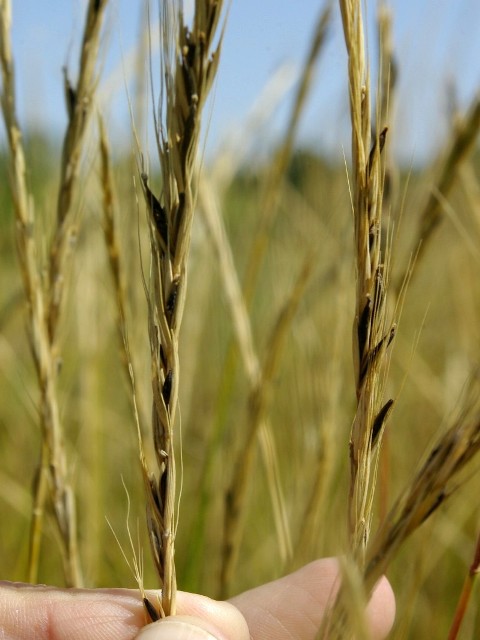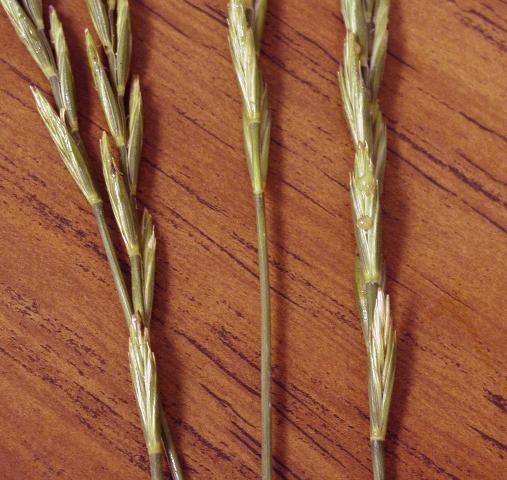Ergot
Ergot infects many cereals and grasses, including, in order of decreasing susceptibility, rye, triticale, wheat and barley. Oats are rarely affected. Yield reductions are usually slight. However, the ergot bodies contain toxic alkaloids that are poisonous to humans and livestock.


Host Crops
Rye, triticale, wheat, barley
Biology
Ergot overwinters as black, grain-sized fungal bodies or sclerotia in the soil and in stored grain for about one year. In spring or early summer, the sclerotia germinate and produce tiny mushroom-like structures. Spores from these are carried by wind and infect open grain florets and immature seed. Infection of the cereal flowers may produce honeydew, a shiny, sticky liquid that oozes from infected florets and contains large numbers of ergot spores.
The spores spread to adjacent flowers and heads by wind, insects, and rain splash. Sclerotia that germinate in June infect early flowering native grasses which later produce honeydew when cereals are flowering. The florets are most susceptible to infection just before anthesis. Infected florets eventually develop dark, hard horn-like structures (sclerotia) instead of normal kernels.
Cool, damp weather in late spring and early summer favour ergot germination and prolong the flowering period of cereals and grasses increasing the opportunity for ergot infection.
Sclerotia return to the soil with the straw and chaff or with contaminated seed stocks. Ergot rarely survives for more than one year in the soil.
Symptoms Of Damage
Conspicuous, purple to black fungal bodies are produced in place of kernels. They are persistent in threshed grain.

Scouting Techniques
Ergot is often found at the edges of fields, moving into the field from grassy margins. Individual heads may contain one or more ergot bodies. When the source is headland grass, the highest density of ergot is around the perimeter, along the headlands. If the infected plants are more evenly distributed throughout the field, the source is probably contaminated seed or a previously infected crop.
Earlier in the season, before the ergots are produced, an amber liquid or honeydew can be seen on individual flower heads. The heads collect dust and pollen on the sticky honeydew and appear dirty. Later in the season, ergot is easily recognized by the hard, black bodies that replace the grains of the affected florets.
Note that, when mature grain is exposed to strong winds, the protruding ergot bodies may be shaken off the head, reducing the amount of ergot in the harvested grain by up to 70%.
Economic Thresholds
Ergot causes losses through a reduction in yield and through rejection or downgrading of contaminated grain. Yields are occasionally reduced by as much as 5% in rye. Contamination in excess of 0.25% in wheat results in downgrading to "sample".
Control Tips
- Delay swathing in headland areas to allow strong winds to shake out the ergots from standing grain. Harvest these swaths separately because they are likely to have the highest ergot contamination.
- Use good sanitation. Cut or burn nearby grasses before they come into head. Clean seed to remove ergot bodies. If a few ergot bodies remain in the seed, plant at least 5 cm (2 in.) deep or store seed for one year to reduce the viability of ergot bodies to almost zero. Cultivate deeply after a crop has been infected with ergot to bury the sclerotia at least 2.5 cm (1 in.) below the soil line or rotate to a resistant crop. Do not sow wheat after rye.
- Leave at least one year between susceptible crops, ie. rye, triticale, wheat and barley. Note that brome and couch grass are extremely susceptible to ergot.
- There are no resistant varieties or effective fungicides. Test soils for copper availability. If copper levels are less than 1 ppm, it may be necessary to apply copper fertilizer to the soil to reduce this disease in wheat and barley.
